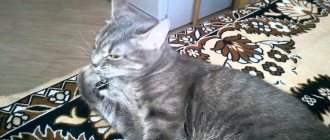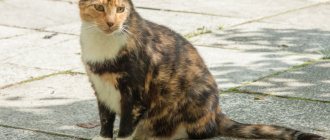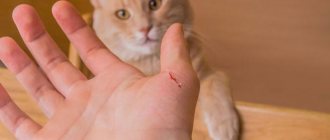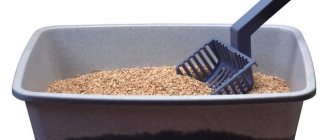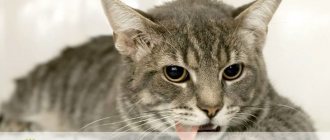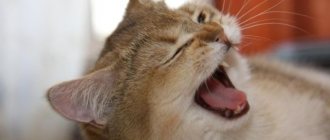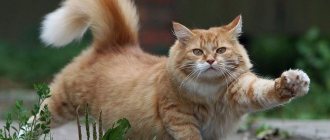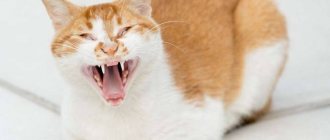We've all seen our kittens preen themselves and then start biting. This may not be reassuring. Is this normal or is it a sign of something more serious? What's behind this strange behavior? Why do cats bite themselves?
Cats may bite themselves while grooming them. Bites are used to clean fur, get rid of insects and remove hairs. A bite may also be a sign of a physical or psychological disorder.
It is important to evaluate your pet's symptoms to determine the cause. In this article, we'll look at this strange behavior, what causes it, and when you should intervene to get your cat to stop biting herself.
So, when do cats chew their claws?
The first and perhaps most common reason that a cat bites its claws is stress. A variety of factors can cause stress, including moving, a new owner, and the addition of new household members, such as other cats, dogs, or children. And if a cat goes outside freely, then there will definitely be no shortage of stressful situations for her. You should also add to the list a visit to the veterinarian, taking certain medications (especially if they involve forced administration and feeding of medication or forcibly restraining a cat), traveling by car, on public transport, or visiting strangers.
What is the reason for a cat's bad habit of biting its claws?
It should be noted that even people can bite their nails when stressed (for example, the legendary director Andrei Tarkovsky was famous for this habit), so it is not surprising that cats do the same. And if the cause of this behavior is indeed stress, then the only way to solve this problem is to identify the causes and eliminate them. If this cause of stress is eliminated, then soon the cat will stop biting its claws.
The second reason may be sore paws. Of course, not every disease of the limbs can lead to a cat biting its claws, but sometimes it happens, especially if it is the paws that are affected and not some other part of the limbs. This may be indicated by the fact that the cat bites its claws only on one or two paws
Observe the cat and which paws become the subject of its special attention, and if the pet’s attention is indeed concentrated on one paw, then it should definitely be shown to a veterinarian who can diagnose the problem and prescribe the appropriate treatment
Stress is the number one reason why a cat bites its claws.
The third reason is a lack of minerals, which the cat tries to compensate for by gnawing its claws. In this case, you also need to consult a veterinarian who will prescribe a vitamin and mineral complex for your cat. A similar problem often occurs in cats that are fed “at random” or “from the table” and a lack of minerals in this case is more likely to be the norm than the exception.
Another reason is infection.
The fourth reason is much more serious. This is a fungal infection that can destroy the nails. For example, with dermatomycosis, one can observe various lesions of the claws of a diffuse or focal nature in the form of foci of crumbly peeling, deformation and turbidity in various parts of the claw. As a rule, the claws of the forelimbs are affected. And if no measures are taken, the disease can last for several weeks or even months, being a source of infection for animals and people around the cat.
Finally, the fifth reason is that the claws are too long. Sometimes they grow so large that they even prevent the animal from moving. This is especially true for those cats that do not have access to the outdoors and whose claws do not wear down naturally. If the cat also leads a sedentary lifestyle, plays little and is not too zealous on the scratching post, then its claws can indeed become unusually long. In this case, you just need to help your pet trim its nails.
This is not at all difficult to do and a detailed description of this procedure can be found, like many other things, on our website. However, those owners who have enough free time and money can simply take their pet to a veterinarian who can carry out this procedure efficiently. You can also use the services of cat beauty salons or professional groomers, who can even come to your home.
Claw caps.
True, in some cases, their owners, who do not have sufficient experience in keeping cats, complain that when they trim their pet’s claws, they begin to crumble and delaminate. One of the reasons for this may be the lack of minerals already mentioned above (what to do in this case was also described above), and the other is scissors. A cat's claws should be shortened using a special nail clipper, which can be purchased at a pet store. As a last resort, you can use small wood cutters, but not scissors. If you use them, even very healthy claws will crumble and peel.
Behavioral motives
A cat may chew its claws if they are not well-groomed. Make sure that the scratching post is in the pet’s constant access; if necessary, update the accessory. Don't forget to inspect your pet's claws once every 1-2 weeks. Claws that are too long and curved need to be shortened with a guillotine nail clipper or nail file.
Pets that walk outside should have their paws examined every day. If your cat appears anxious, make sure that:
- breaks or cracks on the claws - in the case of cracks, the condition should be monitored and, if possible, the claw should be trimmed (if the crack does not touch the blood vessels). If blood oozes from the injured nail or it interferes with the animal's ability to walk, we recommend contacting a veterinarian. By cutting a claw while it's alive, you will cause your pet a lot of pain and cause heavy bleeding. Without care and initial treatment, a short-cut claw is an open wound, which is fraught with infection.
- The pet has not injured a finger or paw - lameness, pain, attempts to bite its own paw and other behavioral oddities may indicate a sprained or torn ligament, fracture or other injury.
- Foreign object – while playing or walking, a cat can get a splinter that gets stuck under the skin. In winter weather, snow gets stuck between the cat's toes, which quickly turns into ice. The difficulty is that the ice causes great discomfort, and if these mini-snowballs contain salt and sand (which is sprinkled on footpaths), they also bake a lot. If a cat does not gnaw out the snow stuck between its toes in time, it risks chemical burns and frostbite.
In a state of severe stress, a cat tends to calm itself by licking. The process emits stroking and stimulates the nerve endings of the hair follicles. In response to licking, the cat's body produces endorphin. A cat that is stressed for a long time may lick areas of its limbs to the point of open wounds. The disease is called lick granuloma.
Note! A licked granuloma is not an injury, but the consequences of a psychological disorder. Treatment involves a complex of procedures: the affected areas are treated, the condition is treated symptomatically with the obligatory use of sedatives.
Trust in the owner
Many cat lovers adhere to the version that this is how the animal expresses its gratitude and love for its owner. This is how they show that they are extremely satisfied. The roots of this habit should be sought in distant childhood: kittens, when they settle on their mother’s belly, alternately move their paws, stimulating the receptors responsible for lactation. So this same action, transferred to adulthood, shows the pacification of the animal.
Scientists call this behavior the “milk step.” It is fixed in animals for life, and they crush not only humans with their paws, but even soft toys and other cats during games.
Of course, the claws released during this game can scratch your skin, but still you shouldn’t scold the cat for this: this is how he expresses his deepest devotion and affection for you, at the same time feeling like a little kitten, protected from all the vicissitudes of fate by his mother.
The main reasons why cats crush people with their paws, and the owner’s actions in case of such behavior
Affectionate furry pets have long gained the reputation of being one of the most mysterious and amazing creatures among domesticated animals. Cat breeders often note such a feature of their pet as the so-called “milk step”. Seeing these unusual movements, many people wonder why cats crush people with their paws.
Animal psychologists have several hypotheses about this peculiar ritual. A cat lover will be interested in finding an explanation for the unusual behavior of his affectionate couch potato.
Read in this article
How to avoid cat bites and scratches
Avoiding bites from your beloved cat and weaning him from biting is an interesting activity. You can use different methods, the main thing is not to forget that repetition is the mother of learning.
A cat with the character of an unstoppable hunter needs to devote more time to games, so fishing rods with feathers or pompoms should be used.
Such teasers perfectly divert the cat's attention from the owner's legs and arms;
If the pussy has already formed the habit of biting the hand during play, then when the cat's teeth touch the skin, the play immediately stops;
A scratching post will eliminate the problem of scratches, especially if it has a hanging fishing rod toy in its design;
For those cats who cannot imagine their lives without scratching their household members, there is an effective measure - anti-scratch products. These silicone caps are glued onto the bully's claws, preventing him from causing damage to people and furniture;
Onychectomy is a last resort measure that the owner can use
Complete declawing will save the owner from scratches, but will it be beneficial for the cat? It's worth learning more about this;
A cat that is playing can be sprayed with water or scared off with a sharp sound - if you do this constantly when trying to bite, the animal will quickly remember that a bite can have unpleasant consequences.
When raising a pet, you need to show restraint, patience, and not forget that a cat first of all needs the attention and love of its owner.
scratching post
Monthly nail trimming does not always relieve your cat of the need to take care of her claws on her own. If you see that your pet, despite timely care, periodically looks for materials on which it wants to “practice,” then it makes sense to think about buying a scratching post. A scratching post will allow the cat’s other needs, which we talked about earlier, to be realized. Marking territory, kneading muscles, grinding claws - all this will be provided by a scratching post for your pet.
A flat scratching post is a convenient place to start introducing your cat to such devices.
Please note that not all cats accept scratching posts. There are times when owners, having bought a huge gaming complex for their cat, sell it as completely unnecessary. To decide whether your pet is interested in this type of leisure activity, you can start by getting acquainted with such a simple and cheap option as a flat scratching post.
For some cats, the purpose of the scratching post remains a mystery.
Types of scratching posts
In addition to the flat version, there are the following types of scratching posts:
- Post – A cylindrical post covered with a stiff material (such as jute).
At the top of such a pillar there is usually a platform on which the pet can climb if desired. Sometimes the posts are equipped with additional toys to attract attention, sometimes they make do with a minimalist design. You can make a claw post with your own hands by taking a leg from a table or coffee table and upholstering it with the appropriate type of fabric; The stand is suitable for both adults and little ones - A scratching post built into the play complex.
On the Internet you can find many design solutions for the location of entire cat “palaces” in apartments. They combine posts, flat scratching posts, beds, and everything you can imagine. It would seem that the cat’s leisure time in such conditions is guaranteed, but sometimes it happens that the pet remains completely indifferent to such “architectural ensembles” in his honor; Play complexes are upholstered with the same materials as flat scratching posts
Fungal infections of claws
A fungal infection affects not only the skin and mucous membranes, but also the hairs and claws of animals. The claws of the front paws are especially affected, becoming:
- thickened and deformed;
- flaky and cloudy;
- crumbling and chipping.
In the severe stage of the disease, the crumpled claw dies.
How to help your pet. It should be remembered that fungal infections are very contagious, so a sick pet poses a danger to both its relatives and the owners themselves. That is why, in case of any suspicious behavior, you should show the cat to a veterinarian and undergo laboratory tests.
If everything is in order with the health of the mustachioed tabby, but the habit of biting its claws is too ingrained, then you can use colored silicone caps from the pet store. They are securely fixed on each claw with glue, giving the pet a glamorous look and weaning it from bad habits.
Poor nutrition and diseases
Like people, cats can chew their claws on their front and hind paws when their diet lacks minerals and vitamins. This is a signal for the owner that it is time to reconsider the diet and add a vitamin and mineral complex to the diet. However, the reason may not be diet - cats bite their claws due to fungal diseases and allergies.
If the cause has not been established, it is recommended to talk to a veterinarian - it will be easier for a specialist to find and eliminate it. It is difficult for the owner to distinguish fungal diseases from injuries that the cat received on the street or at home. Many owners do not pay attention to such little things as the condition of their pet’s claws, and discover the problem already in an advanced stage. If there are no veterinary clinics nearby, you can still find a way out of the situation.
In a situation where a cat eats from the owner's table, it almost certainly does not receive vitamins. It is impossible to take into account all the nuances of a cat's diet; it is easier to choose the right food. With a balanced diet, the problem is most likely a disease.
Read also: Why was the Don River called Don?
Fungal infections in cats are the most dangerous. They last for a long time and cause a lot of problems. Moreover, the owner and members of his family can become infected from the cat, because the fungus is transmitted. It can be identified visually - it affects the nails in patches, creating cloudy areas that peel and crumble.
Possible reasons
The rarest causes include allergies, which in isolated cases affect the paw pads. But it is because of it that swelling, similar to a growth, can appear. This phenomenon can be provoked by insect bites or contact with plants or chemicals.
In 90% of cases, everything goes away on its own within 24 hours. Otherwise, the cat must be given an antihistamine and shown to a veterinarian.
Other reasons are much more common, so we will talk about them in more detail below.
Foreign body
One of the most common causes of a growth on a cat's paw pad. Small splinters can act as splinters (if the house has a wooden floor), needles from plants (cacti, roses), glass fragments, small bones from fish.
Getting a foreign body under the skin can provoke an inflammatory or purulent process. This manifests itself in the form of swelling of the limb and the release of pus when pressed. The problem can only be solved by removing the splinter and treating the wound with an antiseptic solution.
There are also many cases where a foreign body without an inflammatory process became overgrown with epithelium over time, which ultimately formed the development of a growth on the pad. Such formations can only be removed surgically, provided that it interferes with the animal.
Ingrown claw
The phenomenon is more common in adults. If your cat is prone to ingrown claws and doesn't have them trimmed regularly, there is a very high chance that it will grow into the soft tissue. After the claw grows into the paw pad, you may notice how the pet begins to limp or hold its paw suspended.
After examination, you may notice swelling and redness on the pad and digital ball. If a secondary infection occurs, pus will ooze from the wound. It is advisable to show the animal to a veterinarian so that he can assess the extent of the damage and trim the claw to the required length (it is not so easy to do this correctly yourself).
In case of inflammatory processes, it may be necessary to open the wound to clean out pus and claw residues. Subsequently, drainage is applied to the paw, and healing ointments are prescribed.
Cutaneous horn
Very common among cats aged 2-7 years. It is considered one of the varieties of papilloma that does not pose a threat to the health of the animal. At the initial stage, it looks like a keratinized area of flesh-pink skin.
Subsequently it can reach the size of a hazelnut. It is of great importance which side of the pad the growth forms on. If it interferes with walking, it is recommended to remove it. In most cases, the skin horn is not touched, it is observed, since the chance of a malignant course of this type of formation is less than 5%.
Neoplasms
It mainly affects animals over 10 years of age. Benign tumors can reach enormous sizes, but never metastasize or reappear after removal.
It can be distinguished from malignancy using biopsy and cytology. Cancer is also characterized by an aggressive course - rapid growth and manifestation. For fibrosarcomas, the prognosis is guarded. Depending on the size and stage of the tumor, effective treatment is selected - removal of the tumor within healthy tissue or amputation of the limb.
X-rays are of great importance in diagnosis to exclude metastases. For lipomas, the prognosis is favorable; the fat capsule itself is removed.
Skin irritation
Another serious reason for diligent licking of paws and claws is various skin irritations. This could be itching from allergic reactions, vitamin deficiencies, fungal or infectious lesions, insect bites. In this case, the cat tries to get rid of the unpleasant sensations by biting its skin or claws, but the situation only gets worse. Painful places from bites are injured, inflammatory processes and suppuration begin. If such symptoms appear, you should consult your veterinarian.
Playful attitude
One of the main reasons why a cat bites their feet is boredom. The owner should not forget to diversify the animal’s environment, give it a toy, play together and carefully hide objects that it is not desirable for the pet to become an object of interest to.
A cat may have dozens of toys, but too many can become boring. Therefore, you should hide some of them, and display only part of them, and after a while change their places. In this case, the cat will treat the previously hidden toys as a completely new object and will again show interest in the object.
When a cat jumps up to bite, the owner can throw him special toys, previously frozen in the refrigerator, or ice cubes. Biting such cold materials will calm the cat.
Attention! This method is especially applicable for small kittens whose teeth itch. After all, by biting the owner’s legs, they try to soothe pain in the game
Leg biting is a way to attract the owner's attention when the cat wants to play. You should pay more attention to your pet, play with it more often, then the problem will be solved.
A playful attitude is a popular reason for biting the owner's feet.
They are teething
As your kitten begins to lose her baby teeth and her adult teeth emerge, her gums can become sore and irritated. One way to relieve this pain is to chew on something, like a teething baby!
- Solution . If you know your kitten is teething, offer him a few safe things to chew on instead of your fingers. Some kittens like to chew cardboard, just keep an eye on them to make sure they don't eat anything. Others prefer rubber chew toys, and often a puppy toy will work just fine! Once your kitten starts teething, the pain will subside and he will stop chewing.
© shutterstock
What to do?
If the case is advanced, the claw has grown into the finger, the pad of the finger is swollen, or the animal is in pain, the surest option is to contact a veterinary clinic to avoid complications. In such cases, surgery is indicated - the finger is opened and the claw is removed. Do not try to treat your pet yourself if your finger is inflamed and festered! This is fraught with blood poisoning and associated dangerous complications. The operation is not complicated, but it is better not to allow this to happen.
If it happened like it did for me, namely, the claw grew to the finger, slightly ate into it, but did not grow in, the finger does not hurt, the cat does not complain, you can try to deal with the problem yourself.
For this you will need:
- Antiseptic agents - napkins or just cotton wool and any disinfectant - alcohol, vodka, hydrogen peroxide, etc. What you will find in your home medicine cabinet.
- Scissors for trimming animal claws. I recommend that all cat owners have special scissors, since ordinary nail scissors are not suitable for a cat's claw - cutting with them can lead to cracking of the claw.
- If your cat is very restless, you can give him a natural cat sedative. I usually get by without it.
This is how pieces of the claw peeled off. So:
Fix the cat’s paw and sit him down so that the animal does not get nervous or twitch again. Treat your claw and finger with antiseptic just in case. Trim the claw carefully. When trimming, make sure the end of the claw extends freely from the pad of the toe.
If this does not happen, the depth of ingrowth is minimal, slightly pull the claw away from your finger. If it doesn't come out, don't try to pull it out. Grasp the claw with scissors at a distance of about 2-3 mm from the tip and trim it. If the claw is layered and large, trimming can take place in several stages. Cut the claw confidently, but not with all your might (to avoid cracks and injury). In my case, with the first effort, two layers of dead claw came off, and it became thinner. With the second press, another layer came off and the third time it was possible to cut off the first 3 mm. If in your case the claw is still ingrown, after separating it from the pad, try to carefully remove the ingrown piece with tweezers. If you correctly determine that the claw is not deeply embedded, everything should work out. If blood appears, treat your finger with a pre-prepared antiseptic.
That's not all. Since the claw is long, you need to trim it to the end. However, do not overdo it - the fact is that if the claw has not peeled off, it becomes opaque and the vessels are not visible through it. Don’t overdo it, it’s better to cut a little more and gradually remove the remaining length with a regular manicure file. And now that's it.
Why does a cat sharpen its claws?
Also learn about cat declawing{amp}gt;{amp}gt;{amp}gt;
We suggest you familiarize yourself with the age at which a cat can become pregnant for the first time. For a beginning breeder: at what time can a cat become pregnant? How long does this physiological process last?
This is what most often provokes the animal to tear up the sofa, curtains or other suitable surfaces. It is almost impossible to avoid this, so it is recommended to first purchase a special scratching post and accustom the animal to it. The cat will know the right place where it can easily sharpen and put its defense weapon in order.
If a cat chews its claws, or lets them into the owner’s body while lying on its knees, it should not be scolded under any circumstances. Thus, the animal leaves its specific secret on its beloved owner, indicating to other animals that the owner is busy.
Cats' claws are covered with a special scaly membrane. Sometimes the animal pulls them in and gets uncomfortable sensations. That is, this is the reason for the need for cats to sharpen their claws - this is how they remove dead horny scales. Natural peeling occurs roughly once every two months.
Cats also have chains where their claws grow, which they use to mark their territory. People don’t smell the scent, but other cats will immediately understand who’s boss in the house.
Instructions for action
If a cat begins to bite its claws, then it is worth examining them. If the cat's claws are in order, then the problem may be psychological discomfort or a lack of vitamins and minerals. If you suspect a fungus or other disease, you should consult a veterinarian. The easiest way to contact a specialist is to contact him through the application from the website. Here you can make an appointment at the veterinary clinic.
Download the specialized application for pet owners Petstory on the IOS and Android platforms using the link – https:///prilozhenie-konsultacija-veterinar/.
Punishment or ignoring
Is it possible to physically punish a cat? Sometimes this is necessary, and sometimes it can lead to a more severe form of aggression. Having hurt your ward, you explain with your fingers that you are stronger and are able to defend yourself.
If the cause of aggression lies in complexes or insecurity, you humiliate the ward even more than provoke him to more desperate methods of defense. Be that as it may, try to avoid physical punishment, and if the situation is critical, do not break the following rules:
Do not punish with punches or kicks - a rolled-up newspaper, a thin cord, or the click of a stretched elastic band is much more effective and safer. When struck with a palm, a vibration runs through the animal’s body, affecting not only the skin, but also the internal organs.
Do not lock yourself in a confined space - this method is necessary only in case of violent rage or an uncontrolled attack of all living things. Locking a kitten in the bathroom “to make it think” is a critically incorrect strategy that humiliates the pet.
Punish only after the fact of what happened - even 2-3 minutes after the offense, punishment is useless and in the gases of the ward, it looks like deliberate humiliation.
Read with this
Options for weaning a kitten
When a cat attacks its owner’s legs during play, it is necessary to immediately switch its attention to another object. You can stop this behavior by shouting loudly or by spraying her with flower spray.
This will make the cat feel uncomfortable and will help wean it off such pranks.
In order to wean a kitten from biting its legs, you should find the reasons for this behavior and eliminate them:
a kitten needs personal space, for example, a special house, a box - the absence of this is the reason for aggression towards people; ignoring attacks; at the first sign of aggression, you should offer your favorite toy, thereby diverting attention; sometimes a loud shout like: “Ugh!”, “You can’t” helps.
In particularly advanced cases, the use of special odor-repellent sprays helps.
It is necessary to wean a cat from biting from childhood
What products are used to strengthen claws?
A popular vitamin complex is Brevers CALCIDEE 8 in 1. Its main advantage is that it contains only the most important vitamins for the pet’s body and
substances in the required balanced amount (vitamin D, calcium, phosphorus). Thanks to this, the vitamin complex can be taken with any food.
As an alternative, you can consider the Beaphar Kitty's Mix multivitamin complex, it contains a much higher amount of minerals and vitamins, and also contains at least 4% cod.
However, you should be careful when “prescribing” multivitamin complexes to your pet, because they contain many different vitamin groups, an excess of which in the pet’s body will not lead to anything good
Additionally, you can saturate your cat’s body with essential microelements and vitamins using oat sprouts. They can be purchased at any veterinary pharmacy or grown yourself. Sprouts must be added to the animal’s food at least once a week.
It is also recommended to introduce fresh, unheat-treated cod liver, fresh fish, meat and boiled vegetables into the cat’s diet. With an integrated approach, you can get rid of the problem in a matter of weeks.
In order to effectively deal with delamination of cat claws, it is necessary to understand why this happens.
However, there are cases when this phenomenon may indicate health problems.
Lack of minerals
The desire to bite claws may be due to a lack of minerals in the body or their imbalance. Unable to find a more suitable source, the cat gnaws on mineralized parts of its own body. A similar condition is noted:
- with a poor, monotonous diet;
- during a period of intensive growth;
- during pregnancy and breastfeeding;
- after injuries during fracture healing;
- in case of poor calcium absorption and hormonal diseases.
Associated symptoms. An additional symptom of a lack of mineral nutrition is the instinctive need to lick, chew and swallow:
What should the owner do? To correct the situation, it is necessary to transfer the animal to a nutritious diet, using premium and super-premium food, and with natural feeding, provide high-quality vitamin and mineral premixes.
Why does a cat sharpen its claws?
Why a cat sharpens or chews its claws interests many beginners. In addition to sharpening its weapons, the cat sharpens keratinized processes due to discomfort. Thus, dead particles of claws cause inconvenience to the cat in the process of retracting them into the pad. The pet begins to get nervous and tries to bite off or grind off the interfering layer.
We invite you to familiarize yourself with: Havanese Bichon Havanese Havanese lapdog
This is what most often provokes the animal to tear up the sofa, curtains or other suitable surfaces. It is almost impossible to avoid this, so it is recommended to first purchase a special scratching post and accustom the animal to it. The cat will know the right place where it can easily sharpen and put its defense weapon in order.
If a cat chews its claws, or lets them into the owner’s body while lying on its knees, it should not be scolded under any circumstances. Thus, the animal leaves its specific secret on its beloved owner, indicating to other animals that the owner is busy.
Another reason that a cat begins to “sharpen” its claws on its owner is the so-called milk step. This phenomenon is caused by reflexes from childhood. At an early age, kittens intensively knead their mother's belly with their paws and thus stimulate the flow of milk. Not wanting to receive such affection from a mustachioed pet, veterinarians recommend regular trimming of cats' claws or purchasing special caps for the claws.
When the phenomenon is observed
The owner most often observes the peculiar behavior of a domestic cat when the animal is in a peaceful and calm state. At this moment, the pet may purr. Some cats perform the ritual without releasing their claws. Other individuals can crush the soft surface, extending their claws to their full length. At the same time, the animal looks concentrated, the reaction to external stimuli becomes minimal. Some owners compare this state of their pet to nirvana.
Many cat breeders note that the cat ritual usually takes place on a soft and pliable surface: a blanket, a mattress, the owner’s lap. A hard surface is not suitable for such purposes. Often the “milk step” is used in relation to a soft toy.
Most often, a cat crushes a soft object with its paws when it is about to rest or sleep. Expectant mothers begin to prepare the nest for childbirth and offspring, often before an important event they begin to knead the blanket with their paws. Pets love to perform such a mysterious action when they are on the lap of their beloved owner. Fans of cats note that a cat performs such a ritual only with its owner; such affection is not available to a stranger.
To learn about what a “milk step” is in cats, watch this video:
Why does a cat chew its claws?
Our mustachioed friends, cats, are very similar to ourselves, because they have some habits that are identical to humans. One of them is the habit of biting its claws. However, when it comes to pets, they do this for a reason or out of boredom. A cat bites its claws due to certain problems or circumstances. So why do mustaches do this?
There are 5 most common reasons for this:
- The pet has sore paws.
- The cat suffered significant stress for her.
- She lacks minerals.
- The mustachioed man is trying to get rid of his overly long claws.
- The animal has a fungal disease.
shutterstock
So, now let's look at each reason in more detail.
Paw disease
If a cat starts biting its claws, then you need to take a closer look: is it biting the nail on one paw or on different ones. Because sometimes an animal can bite its nails due to a sore limb, namely the paw. In this case, the pet must be shown to a specialist.
Stressful situations
One of the most common causes of nail biting is stress. Of course, if a cat walks on the street, then it can experience a lot of trouble there. But those cats that live in an apartment can also encounter many problems in their life. The reasons that cause stress in a cat are often:
- guests unknown to her;
- the appearance of a new family member - a small child, another cat or another animal;
- changing of the living place;
- new owner;
- traveling by public transport or car;
- visit to the veterinarian;
- taking medications, especially forced ones, or any other health procedures.
shutterstock
If an animal bites its claws precisely because of stress, then it is necessary to identify the cause and eliminate it. Having come out of a stressful state, the cat will stop gnawing on them.
Mineral deficiency
The problem of mineral deficiency is also serious. The cat tries to provide its body with the missing substances by gnawing its claws.
To prevent this from happening, it is necessary to carefully monitor his diet, it must be balanced.
But what to do if a problem of this kind still arises? Of course, you need to contact a veterinarian for help, he will prescribe a complex of vitamins and minerals, and you can easily cope with the problem.
Big claws
Cats also chew their claws for a very simple reason: when they grow too big.
This problem is especially acute for domestic cats who do not leave the apartment, since animals that walk on the street wear down their claws naturally.
To solve this problem, you need to force your pet to lead an active lifestyle and play with it more often. You should also purchase a scratching post for your cat, on which he can sharpen his claws.
shutterstock
Another old and effective method to get rid of this problem is to regularly trim your pet’s nails. However, not many people manage to do it correctly, which is why a lot of other problems often arise due to sloppy haircuts. You can also avoid this kind of trouble by using special silicone caps, which have many advantages. With them:
- no need to cut the cat's claws;
- you can forget about scratching posts and scratched furniture;
- give your pet a very glamorous look, since multi-colored silicone attachments look very unusual on the paws of a mustachioed one.
Fungal diseases
And finally, the last and very dangerous reason is a fungal infection. This disease is easy to detect because it often appears on the claws of the front paws.
Taking a closer look at your pet's claws, you will be able to see their deformation, peeling, clouding and peeling. In advanced cases, the claw may even die. In addition, it should be remembered that a sick pet can become a source of infection for other animals or people.
Therefore, you should definitely use the help of a specialist and follow all veterinary instructions.
In general, if you notice that your cat is biting its nails, you should not push this problem into the background. The sooner you deal with it, the easier it will be for you to avoid further troubles related to your pet’s health.
Self-soothing remedy
Just like humans, cats can bite their claws when stressed.
The monotonous movements of the jaws are similar to the sucking reflex, which at a tender age guaranteed food and safety in the native nest next to the mother. This is why emotional and sensitive cats, having experienced trouble, put their paws in their mouths and do not take them out for a long time.
The psyche of apartment pets, kept in relative isolation and unfamiliar with a variety of stimuli, is especially fragile. Thus, an animal can experience severe stress due to:
- appearance of strangers;
- ongoing repairs;
- change of owner and place of residence;
- transportation;
- a visit to the veterinarian or to an exhibition;
- bathing and hygiene measures;
- injections and other medical procedures.
By analyzing recent events, you can identify the stress factor and become convinced of the psychological nature of the “bad habit.” As soon as the negative event is forgotten, the cat will stop gnawing its claws and calm down.
Injury to the claw, pad or toe
First of all, the owner needs to note whether the cat bites the claws on all paws indiscriminately or prefers the same one. If a pet persistently licks and bites a strictly defined limb, then you should carefully examine the fingers, claws and pads on it for:
- scratches, sores and cuts;
- inflammation of the interdigital membrane;
- stuck splinters, plant thorns, glass fragments and pieces of wire;
- broken and cracked claws;
- inflammation of the claw bed.
What to do. In simple cases, it is enough to treat the paw with an antiseptic solution (hydrogen peroxide, Chlorhexidine, Miramistin) and repeat the manipulation for several days until the wound is completely healed. Removal of foreign bodies and inflammation of the nail bed requires the assistance of a veterinarian.
Physiological reasons for “squabbling”
Let us note that in most cases there is nothing “criminal” in the desire to chew its claws: this is how the cat removes excess cuticle from the base of the claw plates.
Without this, the skin will constantly grow, as a result of which the claw may become non-functional. In particular, it will no longer be able to retract under the paw pads, and inflammation and fungus may develop.
If the cat does not do its own “manicure,” the owner will have to do it. You can do this yourself, or visit a special salon with your pet.
In addition, the frequency of manifestation of this habit greatly depends on the breed of the animal. Thus, purebred cats' claws are usually thin and relatively delicate. These pets very rarely clean their claws, since there is almost no need for this: the claw plates wear down naturally, and therefore practically do not require mechanical trimming.
In outbred and crossbred cats, the claws are most often powerful, the cuticle on them is thick and dense. Therefore, such “Murks” much more often acquire psychological dependence on a bad habit. To prevent this from happening, your pet needs to trim and trim its claws more often, and install a scratching post at home.
Sucking reflex
Every kitten develops a sucking reflex a few minutes after birth. Thanks to this unconditioned reflex, babies are able to feed on mother's milk. Little kittens depend on their mother: she feeds them, takes care of them and gradually introduces them to the “big” world. For a kitten, sucking is not only a way to get food, but also tactile contact with the mother cat. Saturation with milk is accompanied by a feeling of calm and security. Kittens separated from their mother early are not yet ready for independent living; a change in environment can cause them to develop a persistent state of stress. As a result, the kitten may suck its paws to self-soothe. Natural extinction of the sucking reflex occurs by 5-6 months of a kitten’s life. But a bad habit can remain - in stressful situations, a young animal can suck the hair on its paw.
Do I need to trim my claws?
Cats' claws are cut in different situations: to preserve expensive furniture, to remove damaged and diseased plates, so that the animal does not scratch. If a cat bites its claws due to stress, then removing them is not the best solution. It is impossible to wean a pet from a “bad habit” without first finding out what it is.
Stress must be treated by eliminating its sources and calming your pet. After this, the habit usually disappears, and the animal begins to behave adequately. If there are diseases, the claws are trimmed, then the animal undergoes a course of treatment. All procedures are performed by specialists in a veterinary clinic.
It takes the longest to treat fungal infections - such diseases are very resistant to therapy. In addition, it is difficult to apply medications to animals - there is a high risk that the pet will simply lick off the ointment. But after treatment, the cat no longer bites its claws; they grow back completely healthy.
Cats' claws are cut solely to protect furniture and expensive repairs. A special composition is applied to the plates, which hardens. It cannot be chewed; the composition reliably protects claw remains from infection. There is no need to associate nail trimming with treating your pet for a disease.
Why does a cat bite its claws: physiological or psychological problems. How to help your pet?
How often do you see your cat sitting proudly on a cross, with her toes spread and her teeth diligently polishing her claws? The pet clamps each claw with its front incisors and cleans it with a characteristic clicking sound. Some owners are worried why a cat chews its claws, while others are puzzled by the fact that their pet does not pay attention to its manicure. Let's look at what's normal and when to worry.
Quite rarely, but it happens that a cat bites its claws for no particular reason. By analogy with the “bad habit” of a person who bites his nails since childhood, out of boredom or excitement. In this case, the line between “normal” and “abnormal” behavior is very thin, since the process leads to complacency. In fact, how normal the chewer’s condition can be judged only by the depth of stress, and not by the length of the nails or the frequency of strange desires that arise.
Note! Some decorative breeds of cats have weak, thin claws. They rarely worry about sharpening and cleaning their claws and this is normal.
In outbred cats, which have a highly developed hunting instinct, a lack of interest in claws may indicate an anxious state.
When a cat is bored or lonely, the situation may not be limited to biting its claws. Loneliness is a great stress for a domesticated animal, and if the owner does not find time for the pet for a long time, the cat feels abandoned. Against the background of an obsessive anxiety state, a pet can tear out tufts of hair, lick its limbs or scratch its body until it bleeds, and surprise the owner with sharply negative actions.
Note! Active cats with a “cult of the owner” suffer from obsessive neuroses much more often. https://www.youtube.com/embed/lZ9IAD7NWCw
Having studied the works of animal psychologists, we can conclude that biting claws may have causes related to:
- Personal hygiene – most often.
- Illness.
- Behavioral motives, stress, compulsive disorder - least often.
In any case, if your pet's behavior seems strange, you should take her to the vet. According to generally accepted rules, the animal must be examined by a doctor at least once every six months. Agree, it is better to play it safe and get a conclusion that the patient is healthy than to waste time and cause the disease to develop.
Diseases
A cat chewing its claws may be indicating a problem to you, or it may be dealing with it on its own. Observations of animals have led to the conclusion that when there is discomfort, four-legged animals lick, gnaw or scratch the affected area. Since the claws are on the paws, the cat can only scratch them with its teeth.
Itching is an exhausting and very uncomfortable feeling, during which a cat may not easily gnaw, but also pull out its claws. The first cause of itching that should be excluded is allergies, both food and non-food. The disease is accompanied by a wide range of symptoms, the completeness and order of manifestation of which depend on the breed of the cat, its age, physical health, etc.
Vitamin deficiency leads to flaking of the skin, splitting of the nails and the desire to eat inedible things. If your cat bites its claws, try including a vitamin complex containing vitamin D and trace elements in its diet. Of course, such a diagnosis leaves much to be desired, but if you are right (or have not given your cat vitamins for a long time), the pet’s condition will quickly improve.
Fungal or infectious causes are causes that can be identified by examining the claws. Fungi that eat the claws and skin of the fingers lead to modifications of the nail plates, for example, lightening or delamination. The infection sooner or later leads to suppuration, the formation of a hematoma or swelling, which is palpable.
